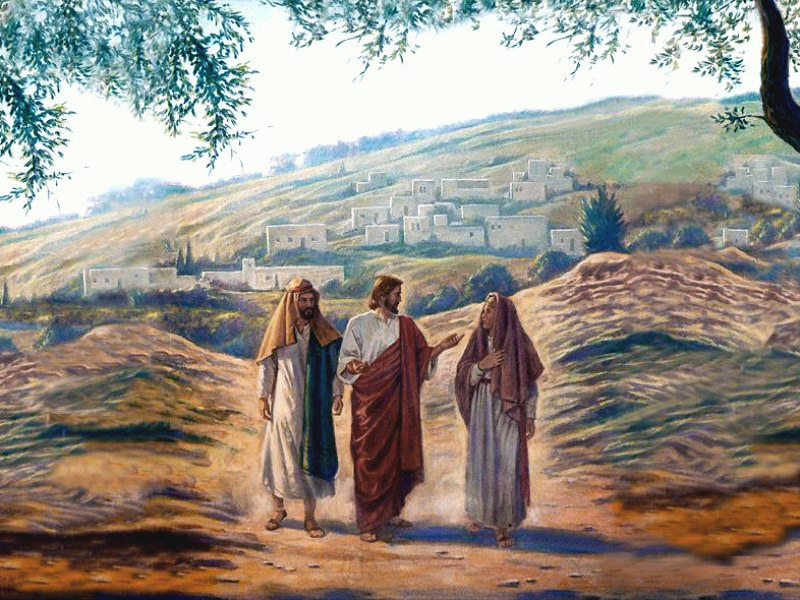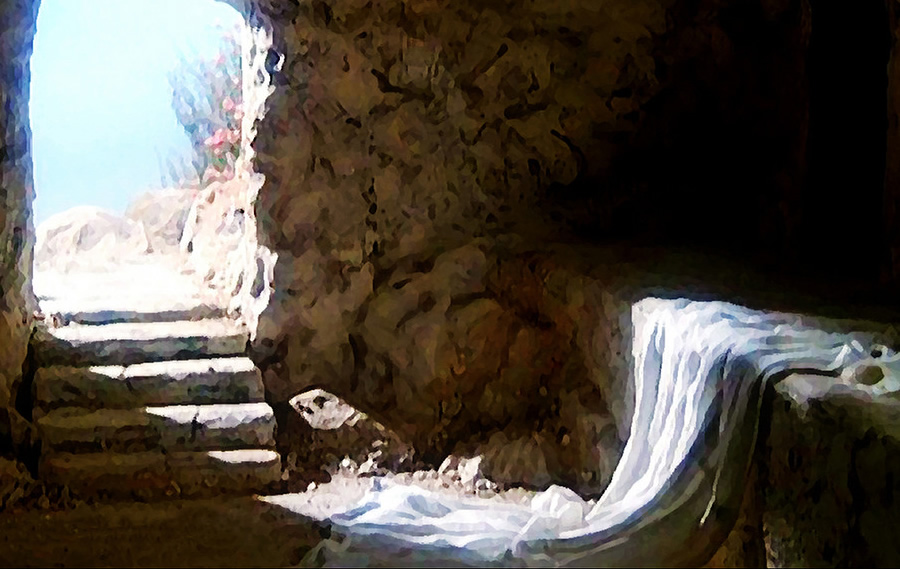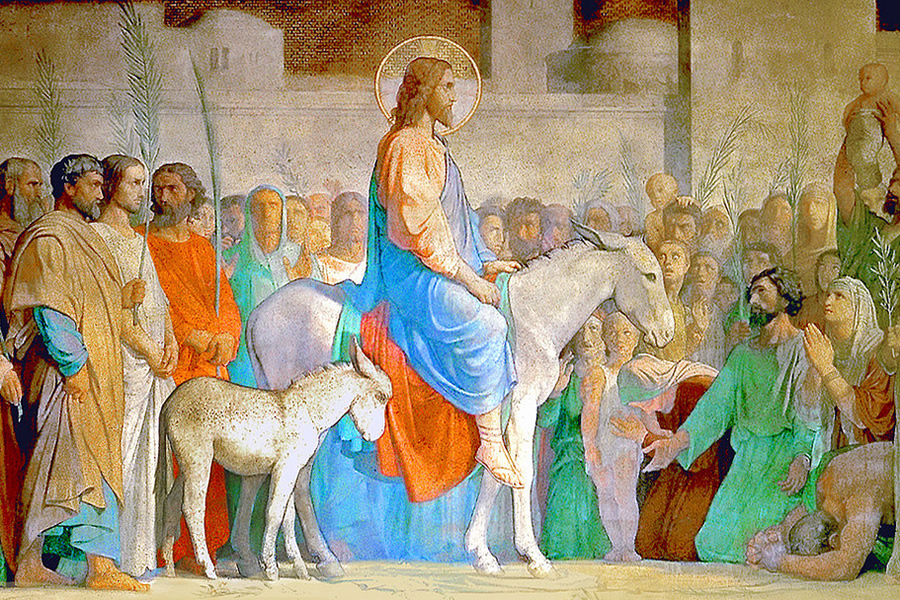St. Francis of Assisi Weekly Reflections

Recongizing Jesus
04-26-2020Weekly ReflectionWe Celebrate Worship Resource, Vol. 45, No. 2When Jesus was born, he was recognized at once. Everyone who came to the stable in Bethlehem, from the shepherds to the magi, understood that he was the Messiah. Even Herod realized it. But recognition was slow in coming when Jesus rose from the dead. Those who entered the empty tomb on Easter morning “did not yet understand the Scripture that he had to rise from the dead” (John 20:9). Last week we heard Thomas assert, “Unless I see...I will not believe” (John 20:25). Today we hear the two disciples walking to Emmaus. Luke writes that “their eyes were prevented from recognizing him” (Luke 24:16). Perhaps he was being kind and the disciples were simply too distracted by their conversation to notice whom they were speaking with. Perhaps the risen Lord looked markedly different. Whatever the reason, it was not until Jesus blessed, broke, and shared the bread that “their eyes were opened and they recognized him” (Luke 24:31). Recognition and understanding simply did not come at once, not for the disciples at the tomb, not for Thomas, and not for these two disciples. Recognizing the risen Lord took time.
How are you failing to recognize Jesus today?
Reconociendo a Jesús
Cuando Jesús nació, fue reconocido de inmediato. Todos los que vinieron al establo en Belén, desde los pastores hasta los magos, entendieron que él era el Mesías. Incluso Herodes se dio cuenta. Pero el reconocimiento tardó en llegar cuando Jesús resucitó de entre los muertos. Aquellos que entraron a la tumba vacía en la mañana de Pascua “aún no habían entendido la Escritura, que era necesario que él resucitase de los muertos” (Juan 20:9). La semana pasada escuchamos a Tomás afirmar: “Si no veo...no creeré” (Juan 20:25). Hoy escuchamos a los dos discípulos caminando hacia Emaús. Lucas escribe que “sus ojos no pudieron reconocerlo” (Lucas 24:16). Quizás estaba siendo amable y los discípulos simplemente estaban demasiado distraídos por su conversación para darse cuenta de con quién estaban hablando. Quizás el Señor resucitado parecía marcadamente diferente. Cualquiera que fuese la razón, no fue hasta que Jesús bendijo, partió y compartió el pan que “se les abrieron los ojos y lo reconocieron” (Lucas 24:31). El reconocimiento y la comprensión simplemente no llegaron de inmediato, ni para los discípulos en la tumba, ni para Tomás, ni para estos dos discípulos. Reconocer al Señor resucitado tomó tiempo.
¿Cómo fallas en reconocer a Jesús hoy?
Recognizing the Lord
04-26-2020Question of the WeekReading I: Acts 2:14, 22-33 - Peter's discourse
Reading II: 1 Peter 1:17-21 - Filial obedience
Gospel: Luke 24:13-35 - Emmaus
Key Passage: While with them at the table, he took the bread, said the blessing, broke it and gave it to them. With that their eyes were opened and they recognized him.
(Luke 24:30-31)
Adults: In what way have you come to know Jesus better through the breaking of the bread at Eucharist?
Kids: When you join Jesus at the table of the Eucharist next Sunday, what would you like to thank him for?
Reconociendo al Señor
Lectura I : Hechos 2:14, 22-33 - El discurso de Pedro
Lectura II: 1 Pedro 1: 17-21 - Obediencia filial
Evangelio: Lucas 24: 13-35 - Emaús
Pasaje clave: Al sentarse a la mesa con ellos, Jesús tomó pan, y lo bendijo; y partiéndolo, les dio. Entonces les fueron abiertos los ojos y lo reconocieron. (Lucas 24:30-31)
Adultos: ¿De qué manera has conocido a Jesús mejor al partir el pan en la Eucaristía?
Niños: ¿Cuando te unas a Jesús en la mesa de la Eucaristía el próximo domingo, ¿por qué te gustaría agradecerle?
The Easter Season
04-26-2020Liturgy CornerThe 12 Days of Christmas and the Christmas Season:
The Christmas season actually lasts 40 days, from Christmas Day until Candlemas, the Feast of the Presentation, on February 2. The 12 days of Christmas refer to the most festive part of the season, from Christmas Day until Epiphany.
What Is the Octave of Easter?
Similarly, the period from Easter Sunday through Divine Mercy Sunday (the Sunday after Easter Sunday) is an especially joyful time. The Catholic Church refers to these eight days (counting both Easter Sunday and Divine Mercy Sunday) as the Octave of Easter. (Octave is also sometimes used to indicate the eighth day, that is, Divine Mercy Sunday, rather than the entire eight-day period.)
READ MOREEncouraging Others
04-19-2020Question of the WeekReading I: Acts 2:42-47 - Communal life
Reading II: 1 Peter 1:3-9 - Thanksgiving
Gospel: John 20:19-31 - Appearance to the disciples; Thomas
Key Passage: Then Jesus said to Thomas, "Put your finger here and see my hands. Reach out your hand and put it in my side. Do not doubt but believe." (John 20:27)
Adults: We show our faith when we demonstrate courage in the face of difficulty. What could you do this week to help strengthen someone?
Kids: What could you do this week to encourage someone who is sad or discouraged?
Animando a los Demas
Lectura I: Hechos 2: 42-47 - Vida comunitaria
Lectura II: 1 Pedro 1: 3-9 - Acción de Gracias
Evangelio: Juan 20: 19-31 - Apariencia a los discípulos; Thomas
Pasaje clave: Luego le dijo a Tomás: "Aquí están mis mano; acerca tu dedo. Trae acá tu mano, métela en mi costado y no sigas dudando, sino cree." (Juan 20:27)
Adultos: Mostramos nuestra fe cuando demostramos valor frente a la dificultad. ¿Qué podrías hacer esta semana para ayudar a fortalecer a alguien?
Niños: ¿Qué podrías hacer esta semana para animar a alguien que está triste o desanimado?
What is Divine Mercy Sunday
04-19-2020Liturgy CornerSantiago Cortes-SjobergThe world was in the midst of the Great Depression in 1931 and the memories of World War I were still very much alive in the minds of Europeans when in Poland a sister of the Congregation of Sisters of Our Lady of Mercy, Faustina Kowalska (1905-1938), is said to have been personally visited by Jesus.
According to her diary, an image was revealed to her of the risen Lord, from whose heart shone two rays, one red (representing blood) and the other "pale" (symbolizing water), with the words "Jesus, I trust in you" at the bottom. Faustina wrote in her diary that Jesus told her, "I promise that the soul that will venerate this image will not perish."
When she was canonized in 2000 under the direction of fellow countryman Pope John Paul II, he proclaimed that the Second Sunday of Easter would henceforth be known as Divine Mercy Sunday, thereby widely promoting the devotional practices associated with Faustina's visions, already popular in many communities.
READ MORE
Oh, Blessed Thomas
04-19-2020Weekly ReflectionWe Celebrate Worship Resource, Vol. 45, No. 2Poor Thomas. He misses one gathering and it turns out to be he one at which Jesus makes his first post-Resurrection appearance. When he returns, they tell him they have seen the Lord. Incredulous Thomas. This must be some crazy collective delusion. He refuses to believe Jesus is risen. Doubting Thomas. Not just a week later, but thanks to this passage from John, for all time. But doubt is just the first stop on the road to faith. All the disciples doubted at first. None of them believed until they saw him, not at the tomb, not on the road, not in the locked room. They first had to be willing to accept what hey could not prove, what was still unknown. The apostles in Acts could not have known when they sold their property and possessions that it would all work out. But they willing to believe that it would. Those who read the first letter of Peter could not know that suffering through various trials would eventually result in rejoicing with an indescribable and glorious joy. So, in the end: Blessed Thomas. He has modeled for us the first step to faith.
How do you overcome doubt and believe what you cannot see or prove?
Oh, Bendito Tomás
Pobre Tomás. Faltó a una reunión y resultó ser aquella en la que Jesús hace su primera aparición posterior a la resurrección. Cuando regresó, le dijeron que habían visto al Señor. El incrédulo Thomas. Esto debe ser un loco engaño colectivo. Se niega a creer que Jesús ha resucitado. Tomás el incrédulo. No solo una semana después, sino gracias a este pasaje de Juan, por todos los tiempos. Pero la duda es solo la primera parada en el camino hacia la fe. Todos los discípulos dudaron al principio. Ninguno de ellos creyó hasta que lo vieron, ni en la tumba, ni en el camino, ni en la cuarto cerrado. Primero tenían que estar dispuestos a aceptar lo que no podían comprobar, lo que aún era desconocido. Los apóstoles en Hechos no podrían haber sabido cuando vendieron sus propiedades y posesiones que todo saldría bien. Pero estaban dispuestos a creer que así sería. Aquellos que leyeron la primera carta de Pedro no podían saber que el sufrimiento a través de varias pruebas eventualmente resultaría en regocijarse con una alegría indescriptible y gloriosa. Entonces, al final: Beato Thomas. Él nos ha modelado el primer paso de la fe.
¿Cómo superas la duda y crees en lo que no puedes ver o comprobar?

He is Risen
04-12-2020Weekly ReflectionWe Celebrate Worship Resource, Vol. 45, No. 2Today we celebrate Jesus’ victory over death. He is risen! Death is not the end. But the Resurrection is not the end either. The world did not end on that first Easter Sunday. Those who discovered the empty tomb ran to tell the other disciples. The disciples, who would soon be visited by the resurrected Jesus, were sent out to convey the good news to the ends of the earth. Those witnesses, evangelized by the original disciples, were called in turn to give witness to others. Generation after generation, the testimony continued. Now, dozens of generations later, we receive the Risen Lord through the word and the Eucharist, then attest to his abiding presence in our lives. In doing so, we follow in the footsteps of Peter and Paul, testifying in word and action to the One who loves us, forgives us, and has redeemed us. We put ourselves in God’s hands, readying ourselves for the new yeast. Like a fresh batch of dough, with new yeast we too shall rise. With this in mind, we renew our baptismal promises every Easter. Promising to serve God by our lives, we are reborn with water and the Holy Spirit, assured forgiveness of our sins, and graced with the promise of eternal life by the One who has conquered death and sin.
How can you witness to the promise of the Resurrection in the way that you live?
¡Él Ha Rsucitado!
Hoy celebramos la victoria de Jesús sobre la muerte. ¡Él ha resucitado! La muerte no es el fin. Pero la resurrección tampoco es el final. El mundo no terminó ese primer domingo de Pascua. Los que descubrieron la tumba vacía corrieron a contarle a los otros discípulos. Los discípulos, que pronto serían visitados por el Jesús resucitado, fueron enviados a transmitir las buenas nuevas hasta los confines de la tierra. Esos testigos, evangelizados por los discípulos originales, fueron llamados a su vez para dar testimonio a otros. Generación tras generación, el testimonio continuó. Ahora, docenas de generaciones después, recibimos al Señor Resucitado a través de la palabra y la Eucaristía, y luego damos fe de su presencia permanente en nuestras vidas. Al hacerlo, seguimos los pasos de Pedro y Pablo, testificando en palabra y acción a Aquel que nos ama, nos perdona y nos ha redimido. Nos ponemos en las manos de Dios, preparándonos para la nueva levadura. Como un nuevo lote de masa, con levadura nueva nosotros también nos levantaremos. Con esto en mente, renovamos nuestras promesas bautismales cada Pascua. Prometiendo servir a Dios por nuestras vidas, renacemos con agua y el Espíritu Santo, con el perdón de nuestros pecados seguro y honrados con la promesa de vida eterna de Aquel que venció la muerte y el pecado.
¿Cómo puedes dar testimonio de la promesa de la resurrección en la forma en que vives?

Imagine Yourself in Each Crowd
04-05-2020Weekly ReflectionWe Celebrate Worship Resource, Vol. 45, No. 1Traditionally, two Gospels are read on Palm Sunday: one featuring Jesus’ triumphant entrance into Jerusalem and the other recounting his Passion, from the Last Supper to his death and burial. Throughout the entire time, Jesus is faithful to his mission and to his Father’s will. But the difference in the crowds in their two key scenes couldn’t be starker. As Jesus rides into Jerusalem, the crowds treat him as royalty, crying out hosannas as they cover the dirt road with tree branches and their own cloaks. But during his trial, the crowd has completely turned against him. It is not enough that they are no longer honoring and praising him. Now they are crying out, “Let him be crucified” (Matthew 27:22, 23). Their behavior recalls the actions of the people in today’s first reading who strike and spit at Isaiah’s suffering servant, abusing him as the religious leaders and soldiers would do to Jesus at his trial. Like the suffering servant, Jesus “humbled himself, becoming obedient to the point of death” (Philippians 2:8). Because of this, for generation upon generation, crowds of people all over the world have bent their knee at the name of Jesus, as we do here today, praising him for offering his life for us, calling upon him for strength to accept our own sufferings, and confessing him as Lord.
READ MORE